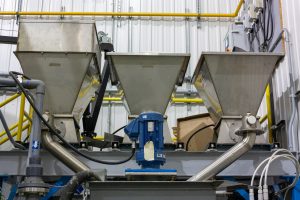
Flow aids can help clear material bridging in hoppers or any other storage bin, chute, or conveyor. They are relatively inexpensive, and can actually “pay for themselves” because of the increase in productivity.
It’s important to get the right flow aid for your material. The wrong flow aid may not be able to activate the material, or may even cause material blocks to compress even further. Some flow aids also create other problems, like high energy costs or damage to the vessel.
Here is a simple guide to the different flow aids, so you can pick the best one to clear material bridging in a hopper.
Industrial Vibrators
Industrial vibrators use mechanical agitation to improve material flow. The movement breaks a material’s cohesive friction and loosens it from vessel walls. They are sometimes called vibrating dischargers or agitators.
However, vibrators are not very efficient. They can make some materials settle or become compact—think of how you shake the measuring cup to condense brown sugar. That’s fine if you want to bake cookies, but not if you’re trying to achieve material flow in your plant.
That’s what happened to Flax4Life, a commercial bakery that produces gluten-free muffins, brownies, and other baked goods. “The vibrators that came installed on the bottom of the hopper above the mixture practically turned the flax into concrete,” said Stanley Rhea, the maintenance department head.
Vibrators can also still leave residue on vessel walls, which means you still need to do manual cleaning between batch runs. That wastes time and even increases costs. A spice company spent an average of $200,000 just on flushing material for their ribbon blenders.
Finally, industrial vibrators consume a lot of energy, are very noisy, and can cause metal fatigue.
Fluidizers
Fluidizers use a combination of aeration and gentle vibration to activate the material. While these are one of the most inexpensive flow aids (sometimes, they come pre-fitted into storage vessels) they are only effective for light powders like flour.
Fluidizers also have a very small activation radius, so you may need dozens of them to correct material bridging in a hopper. Since the units run continuously, you will have higher energy costs. So, even if it is “cheap” it is not cost-efficient, and you may end up spending more in the long run.
Air cannons
Air cannons release a high-pressure blast of air (typically compressed to 100 PSI) to disperse material.
While air cannons seem powerful, it actually provides limited results. Air tends to “channel” through holes in the material, greatly diminishing effectiveness. It also leaves material residue on the walls and often has “blind spots” where material can still collect. You also cannot control the feed rates.
Air cannons also cause a lot of metal fatigue, and will actually cause damage to the vessels. The loud blasts of noise can also be very stressful for workers, and long term, can cause hearing problems.
AirSweep
AirSweep is a pneumatic flow aid that uses short, powerful pulses to push material back into the flow stream. It can activate any kind of material—even moist, sticky, and heavy powders and solids. It even works on liquid cheese.
Watch this video to see how AirSweep is the most effective solution to material bridging in hoppers:
Many companies switched to AirSweep simply because it worked better than any other flow aid. Flax4Life tried vibrators and fluidizers, and neither of them worked. “AirSweep got a 10/10!” said Stanley Rhea.
Heidelberg Cement, one of the largest building materials companies in the world, also found that AirSweep was more effective than air cannons. “AirSweep worked perfectly!”
Get the right flow aid for your material
We can customize the AirSweep system for your process. We have different models with various activation ranges and a USDA-accepted model for sanitary processes. Our AirSweep Straight Shooter can also release a vertical column of air for chutes or hard-to-reach areas.
Get a free proposal today, and finally solve material bridging in hoppers for good.





Comments are closed